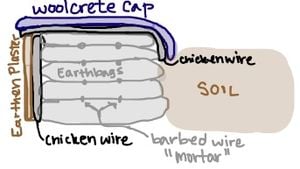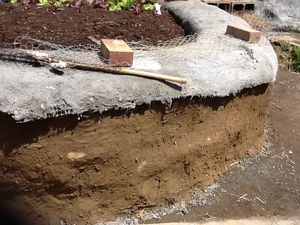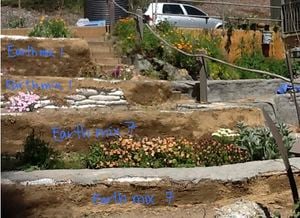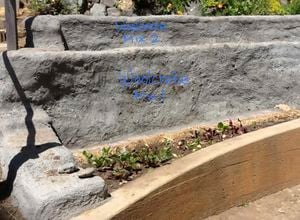
Welcome to the page for the CCAT Earthbag Terrace, located in front of the Campus Center for Appropriate Technology at Cal Poly Humboldt.
The Campus Center for Appropriate Technology (CCAT) is located near the Behavioral and Social Sciences building on the Cal Poly Humboldt campus in Arcata, California. Our original project idea was to build a small informational sign wall to welcome students to the northern entrance to CCAT, and alert readers to upcoming events hosted at CCAT. Due to bureaucratic rigamarole, this project has been changed to a natural plastering project on the CCAT grounds. This project's purpose is to provide a sturdy, natural plaster covering to the EarthBag gardening terrace being built in front of CCAT.
This project is to be completed during the Spring 2012 semester of ENGR 305 class by Danielle Burkhart, Morgan Murphy and Cody Hill.
The objective of this project is to protect the EarthBag terrace at CCAT from the elements and add an aesthetic element by layering natural plaster over the wall to give it an adobe effect.
Criteria[edit | edit source]
| Criteria | Constraints | Weight |
|---|---|---|
| Structural Stability | Must withstand Arcata climate and the elements with routine maintenance. | 10 |
| Effectiveness | Must reflect the values and culture of HSU/CCAT. | 9 |
| Cost | Should cost as little as possible. | 8 |
| Embedded Energy | Construction should be less embedded energy than traditional retaining wall construction. | 7 |
| Materials Quantity | Must be as few as possible, with as little waste as possible, without compromising structural integrity. | 7 |
| Administrative Review | Proposed method must meet requirements for CCAT approval. | 9 |
| Aesthetics | Must be visually attractive, complementary to surroundings and must demonstrate natural building technique. | 10 |
Literature Review[edit | edit source]
This is a review of the available literature pertinent to the EarthBag Terrace at CCAT.
EarthBag Basics[edit | edit source]
The gardening terraces in front of CCAT are being constructed from EarthBags and barbed wire. The EarthBags are polypropylene bags filled with a mix of on-site soil and clay soil from a local landscaping company. Containing about 5%-25% clay,the soil is moistened then transferred to the bag.[1] The bags are sewn shut with bailing wire then laid like bricks in courses, with barbed wire acting as the mortar to grip the bags and hold them in place. The soil is compressed and hardens as it dries. Earthbags are not extensive or costly, they are user-friendly and can be built on a variety of foundations.[1]
| Earthbag Advantages[1] | Earthbag Disadvantages[1] |
|---|---|
| Requires no power tools | Getting approval may be difficult |
| Easy to learn, simple | It's a new technology so you are a guinea pig |
| Suitable for many different climates/regions | |
| No precise soil mixture, you have wiggle-room | |
| Earthbags are thick and lend themselves to passive solar design |
Erosion[edit | edit source]
Since the garden terrace will not incorporate a covering to protect the plaster from the large amounts of rainfall native to Humboldt county, an other approach must be employed.
Plastering[edit | edit source]
All 4 types of plaster have their disadvantages. Like cement plasters, the natural plasters require 3 coats of plaster to be complete.[1]
"Fat Plaster"[edit | edit source]
Fat plaster is a strong, durable and easy to apply natural plaster. "The combination of three distinct sizes of well-graded fiber mixed with a typical plaster soil of (approximately) 25% clay and 75% well-graded sand has produced a strong crack resistant plaster."[2] "...a single coat of piping hot, boiled linseed oil can be used a sealer/stabilizer over a fat plaster to inhibit mold and extra resilience".[2]
Lime-Based Plaster[edit | edit source]
The major ecological concern for lime-based plaster is due to the quantity of material extracted from individual sites. Lime is manufactured by heating limestone, chalk or shell deposits to a high temperature. When CO2 is involved, the end-product is quicklime which is combined with water to produce slaked lime which, when made into plaster, absorbs atmospheric CO2 while hardening.[3] Some builders apply two coats of earthen plaster before a final coat of lime plaster. The lime plaster allows the wall to breathe. The lime naturally becomes water resistant over time as it hardens, and is easy to repair. For building use, always use builder's lime mixed with water to skim milk consistency. Lime is caustic, so protection is important when working with lime.[1]
"...it can take many decades for the lime binder in lime plaster to convert substantially into calcium carbonate. However, if the plaster has been adequately protected during the period of substantial carbonising, for example by application of limewash(lime mixed with materials such as tallow and linseed oil)every couple of years, the resultant calcium carbonate has very low solubility in water and therefore little tendency to weather".[4]
"Lime plaster...is typically applied on exterior walls where it provides excellent protection against the elements".[5]
"A mixture of alum and water and a mixture of soap and water are alternately mopped onto the surface of a lime-plastered surface. This method of water resistance has been used effectively in Mexico for decades. Usually applied to parapet tops, horizontal surfaces, and domes, several alternating coats will give ample protection for many years."[6]
Lime plaster is an extremely durable and highly protective wall surface. its ability to permit the escape of water vapor within its walls makes it an ideal in rainy climates. in dry climates the walls must be misted up to three times a day for a few weeks so the lime does not dry out too quickly. if it dries out too quickly it will weaken the material and can cause it to crumble off.[7]
Gypsum-Based Plaster[edit | edit source]
Make sure to include description, advantages and disadvantages, and/or have a comparison matrix. Made from Calcium Sulfate, which is now produced as a by-product of scrubbing Sulfur Dioxide out of power station emissions.[3]
Gypsum is composed of the mineral calcium sulfate. It is widely available and easy to work with, you only have to mix it with water before applying. It is most effective in two coats. Gypsum expands as it dries so it eliminates cracking. small hairline cracks might happen but it is easy to fix, just smooth it over with a wet sponge. Gypsum is too water soluble to put on exterior walls and will melt away in rain or wet climates.[8]
Cement-Based Plaster[edit | edit source]
The environmental concerns surrounding this type are due to the process by which cement produced, which emits intensive amounts of CO2 as well as metals and sulfur oxides into the atmosphere.[3] Earth based plasters must 'breath' or have a humidity exchange with the surrounding atmosphere to lose water absorbed from the surface. Cement plasters make it difficult for this to happen. Cement plasters are waterproof and wil not allow for necessary breathing of the earth wall. This will lead to a buildup of moisture between the plaster and the wall which will create the plaster to crack and crumble off exposing the natural wall underneath.[9]
Base Coat Project Costs[edit | edit source]
| Quantity | Material | Source | Cost ($) | Total ($) |
|---|---|---|---|---|
| About 2 yd3 | River Sand | Provided by CCAT | 0.00 | 0.00 |
| About 1 yd3 | Clay | On-Site at CCAT | 0.00 | 0.00 |
| About 20 lbs. | Wool | Local Maple Creek Farm Source | 0.00 | 0.00 |
| 4 bags, 94 lbs. each | Cement | Local Hardware Store: Arcata Lumber | 12.79 | 51.16 |
| 3 Pairs | Gloves (for handling cement) | Provided by CCAT | 0.00 | 0.00 |
| 1 each | Wheelbarrow, Shovel and Garden Hoe (for mixing) | Provided by CCAT | 0.00 | 0.00 |
| 3-5 | Buckets | Provided by CCAT | 0.00 | 0.00 |
| Total Cost | $51.16 |
Timeline[edit | edit source]
| Dates | Objective |
|---|---|
| Feb 6 - March 23 | Research & planning, gather materials. |
| March 30 - April 13 | Test potential plaster mixes and choose the best. |
| April 20 - May 7 | Mix plaster and apply to the retaining walls using chosen test mixes. |
Design[edit | edit source]
Base Coat[edit | edit source]
This project serves as an experiment for two earthbag covering techniques: Woolcrete (lower embedded energy than an all concrete covered wall) and an earthen plaster containing wool.

Because the earthbag terraces are going to be walked upon and subjected to Humboldt County weather without an overhead covering, we used a "woolcrete" cap on top of the earthen plaster sides for durability and protection.

We tested seven different earth plaster mixes of varying proportions (see Fig. 7 in the Gallery), and decided to use test mixes 1 and 7 for two walls each and an additional two test walls for two woolcrete only mixes. Mix one contained 2 parts clay to 1 part wool, while mix seven consisted of 3 parts clay to 2 parts wool to 1/2 part river sand.

These were chosen because they held up to blunt force (kicking, beating with objects) and being sprayed with a garden hose with attachment set to high pressure. We applied the mixtures by hand finding that it was the most efficient and easiest method of application. We were also able to re-use most of our testing materials in the plastering of the walls. We filled in gaps between the chicken wire and the bags with small rocks in the clay and wool clumps to try to even out the surface and increase adherence.

Each of our woolcrete mixes contained of a mixture of 1/2 part Portland cement and 1 part river sand. Mix one used two parts of the cement/sand mixture to one part shredded (various sizes) Scottish Blackface wool sourced from a local sheep rancher. Mix two used a 1 part mixture to 1 part wool ratio. When using cement or anything containing lime, it is important to remember to use protective gear to prevent burns to your skin because lime is so basic. We wore gloves to apply our woolcrete mixture to the wall by hand. We mixed in small batches to prevent the cement from drying too quickly before being applied.
Top Coat[edit | edit source]
To be completed beyond the Spring 2012 Semester
Finish[edit | edit source]
To be completed beyond the Spring 2012 Semester
Gallery[edit | edit source]
-
Fig 1: Earthbag terraces with chicken wire attached using long nails, before plastering.
-
Fig 2: Cody prepares the test surface.
-
Fig 3: Morgan unravels chicken wire to attach to the test surface.
-
Fig 4: Clay dug up on CCAT grounds from the new greenhouse foundation to be used in our earthen plaster.
-
Fig 5: Kimberli Hudson demonstrates the clay squeeze test.
-
Fig 6: Morgan and Cody prepare test batches of earthen plaster.
-
Fig 7: Morgan tests 7 earthen plasters
-
Fig 8: Earthen plastering in progress on terraces.
-
Fig 8: This is the type of cement we used in the woolcrete mix.
-
Fig 9: Woolcrete plastering in progress on 2 of the terraces.
-
Fig 10: Woolcrete walls covered in 2 different woolcrete mixes.
-
Fig 11: The terraces drying in the sun.
October 2014 update[edit | edit source]
Last documented update explained that the original project's estimated time of completion was not able to be met as planned. It was later updated and informed that the project would eventually be completed beyond the Spring 2012 semester term as the overall size and duration of the project was more labor intensive than expected as well as there being many more weather related delays than earlier anticipated.
After visiting and assessing the CCAT earth bag terrace garden project, it is visibly apparent that there have been extensive weather related damages incurred to the plaster and Cobb used to support and insulate the terrace walls since it was originally built in 2012. After interviewing close stakeholders involved with the project and gathering overall information about current status and progressions of the project, the overall assessment of the project is that because the plaster and Cobb used to support the walls are very delicate and susceptible to bad weather, specifically rainy weather, very moist and humid regions like the town of Arcata, in Humboldt County are not the ideal or most suitable type of environments for these low embedded energy methods of experimental plasters and Cobb mixes. In addition to being very susceptible to bad weather conditions, it is also very inconvenient and difficult to keep up and maintain the plaster in humid wet conditions. The ideal climate for these materials to fulfill their potential is sunny and hot weather because it is a necessity when trying to work with and repair plaster and Cobb wall substitute mixes. These substitute mixes would be most useful in places like the southern United States and other desert climates.
After further observing and investigating extensively the general Earth-Bag Terrace Garden Project and it's low embedded energy and emissions model, it is evident to conclude that majority of the left side (section 1) of the Terrace plaster and Cobb insulation supporting and insulating the garden walls have either fallen completely apart and crumbled or been damaged severely and are in need or repair and maintenance.
One of the more successful and durable aspect of the project was the cement based mix, woolcrete, used to cover and reinforce the top surfaces of the garden terrace walls. Not only did the woolcreet help support and keep the walls stronger and more durable enabling visitors to safely stand and walk on them, but it also gave the general terrace garden project a pleasing aesthetic appearance adding colors and appeal to the garden terrace funk shui in addition to incorporating matching color schemes with the University, which was apparently a requirement made by the campus administration.
-
Fig 1: Panoramic View Of Current State and Appearance as of October 2014/ Cal Poly Humboldt CCAT EarthBag Terrace Garden Project
-
Fig 1a: Same panoramic view as Fig.1 with the addition of having the different plaster mixes used labeled to assigned walls
-
Fig 1b: Cal Poly Humboldt CCAT EarthBag Terrace Garden,Overview of Overall Damages Labeled
-
Fig 1c: Cal Poly Humboldt CCAT EarthBag Terrace Garden View from Top Angle
-
Fig 2: Cal Poly Humboldt CCAT EarthBag Terrace Garden Section 1 (left Side) Damages
-
Fig 2a: Cal Poly Humboldt CCAT EarthBag Terrace Garden More Section 1 (left Side) Damages
-
Fig 2b: Cal Poly Humboldt CCAT EarthBag Terrace Garden Close Angle View Section 1 (left Side) Damages
-
Fig 2c: Cal Poly Humboldt CCAT EarthBag Terrace Garden Alternate View Close Angle Section 1 (left side) Damages
-
Fig 3a: Cal Poly Humboldt CCAT EarthBag Terrace Garden Improper Mix Wall Section 1 (left side)
-
Fig 3b: Cal Poly Humboldt CCAT EarthBag Terrace Garden Improper Mix Wall Repairs Section 1 (left side)
-
Fig 4a: Cal Poly Humboldt CCAT EarthBag Terrace Garden Section 2 (right side)
-
Fig 4b: Cal Poly Humboldt CCAT EarthBag Terrace Garden Section 2 Close Up (right side)
October 2016 Update[edit | edit source]
Present[edit | edit source]
Over time, a few off the earthbag terraces have had a bit off erosion and are starting to crumble due to the amount of rainfall in Humboldt county. One of the walls, with a mostly cement mixture over top of the cob, has suffered some deterioration. When it rains, the earthbags swell and expanded, the cob will flex with the swell of the earthbags. However, the cement mixture does not flex and the swell caused the cement mixture to crack. For now, the terrace is covered to protect it from the elements before they can begin work to repair it. Right now, CCAT is started a small earthbag terrace side project towards the back of the house. The terrace, presently, is stacked 5 layers of earthbags high with barbed-wire layered between the layers to hold then sturdy and in place, acting as a mortar. Once finished, this terrace may be home to a few strawberries in the future.
Future Plans[edit | edit source]
CCAT has plans to create a community garden directly across the street from their building. They will start by excavating the earth and creating flat and even surface for the garden. To stay green and minimize their waste, CCAT will take the excess dirt from the excavation and use it to fill earthbags. These earthbags will be used to build a retaining wall for the garden. CCAT has plans to begin this project in November before it rains. In the future, CCAT has plans to test out a different building material from the earthbags. One CCAT member mentioned that they plan on testing out durability of bricks they'll make. The bricks will be made out of a cob-cement mix, then will be tested in the engineering department to do a stress test. They also will test the bricks against the elements doing a wetness stress test. Once a good mixture for the bricks has been tested, the bricks will be used in place of the terraces. This is due to the cob mixture not withstanding to the elements of the Humboldt weather conditions.
-
The earthbag terraces here are cracked and covered to protect them from any further damage from the weather.
-
On the left you can see new screen being added to the terrace for added support, stability, and grip for the Cob.
-
Here, a terrace has been patched up. Now it needs to be smoothed out and painted over to match the rest of the terrace.
-
Here, you can see the swelling of the earthbags pushing the terrace out. This was the cause of the cracks in the cement mixture.
-
This is the start of a new terrace near the side of the house. This terrace may be home to strawberries in the future.
-
A few earthbags that have been recently filled to be used on the next project.
References[edit | edit source]
- ↑ 1.0 1.1 1.2 1.3 1.4 1.5 Chiras, Daniel D.. The Natural House: A Complete Guide to Healthy, Energy-Efficient, Environmental Homes. White River Junction, Vt.: Chelsea Green Pub., 2000.
- ↑ 2.0 2.1 Hunter, Kaki., Kiffmeyer, Donald. Earthbag Building: The Tools, Tricks, and Techniques. Canada., 2004.
- ↑ 3.0 3.1 3.2 Harland, Edward. Eco-Renovation: the ecological home improvement guide. Dartington: Green Books in association with the Ecology Building Society, 1993.
- ↑ Practical straw bale building. Collingwood VIC, Australia: Landlinks Press, 2005
- ↑ Guelberth Cedar R., and Chiras Daniel D., The natural plaster book: earth, lime and gypsum plasters for natural homes, Trancontinental printing: Canada, 2003, 12.
- ↑ Hunter, Kaki., Kiffmeyer, Donald. Earthbag Building: The Tools, Tricks, and Techniques. Canada., 2004.
- ↑ http://www.motherearthnews.com/Do-It-Yourself/2003-02-01/Perfect-Plaster.aspx?page=4#ixzz1mDtFNkqh
- ↑ http://www.motherearthnews.com/Do-It-Yourself/2003-02-01/Perfect-Plaster.aspx?page=5#ixzz1mDudAWL0
- ↑ Rainer, Leslie; Rivera, Angelyn. 2006. The Conservation of Decorated Surfaces on Earthen Architecture. p112



























